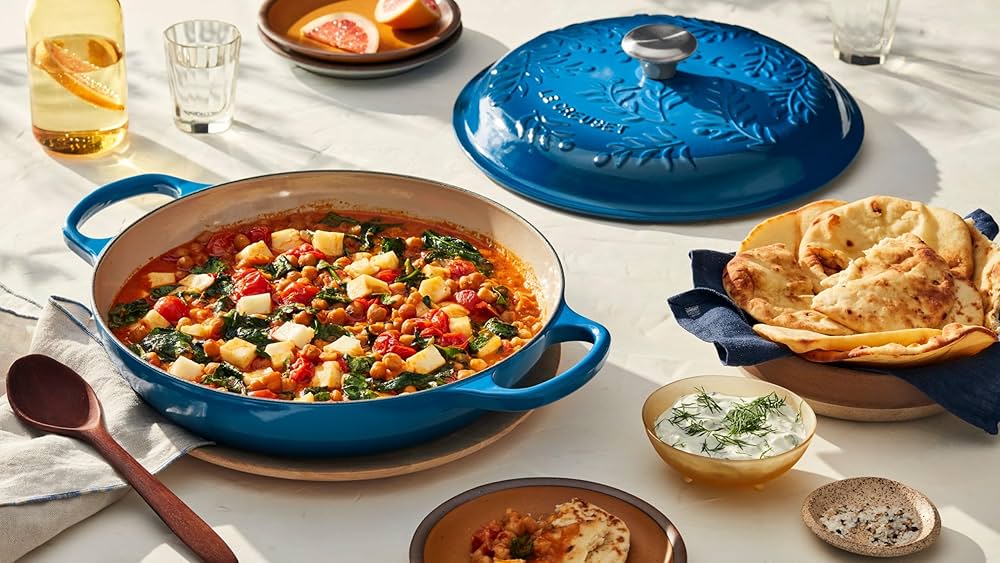When it comes to choosing the right cookware for your kitchen, the decision between a cast iron braiser and ceramic cookware can be a tough one. Both types of cookware have their unique features and benefits, making them popular among home cooks and professional chefs alike. In this article, we will explore the differences between these two types of cookware to help you make an informed choice.

What is a Cast Iron Braiser?
A cast iron braiser is a versatile piece of cookware known for its ability to conduct and retain heat exceptionally well. It is a heavy, durable pan with a wide base and shallow sides, making it perfect for browning meats, sauting vegetables, and slow-cooking dishes. The cast iron braiser is often coated with enamel, which prevents rusting and makes it easier to clean.
What is Ceramic Cookware?
Ceramic cookware is made from clay that is fired at high temperatures to create a non-stick surface. It is known for its aesthetic appeal and ability to distribute heat evenly. Ceramic pots and pans are often lightweight and come in various colors and designs, making them a favorite among those who enjoy showcasing their cookware in the kitchen. Ceramic cookware is also praised for being free of harmful chemicals like PFOA and PTFE.
Comparing Heat Retention and Distribution
Cast Iron Braiser
The cast iron braiser is renowned for its excellent heat retention. It takes longer to heat up but maintains a consistent temperature, which is ideal for slow-cooked meals. This feature makes it perfect for dishes that require long cooking times, such as stews and braises.
Ceramic Cookware
Ceramic cookware heats up quickly and distributes heat evenly across its surface. This makes it suitable for tasks that require even cooking, such as frying eggs or making sauces. However, it may not retain heat as well as cast iron, which can be a drawback for slow-cooked recipes.
Durability and Longevity
Cast Iron Braiser
With proper care, a cast iron braiser can last for generations. It is incredibly durable and resistant to scratches and dents. While it may require seasoning and special handling to prevent rust, its longevity makes it a worthwhile investment.
Ceramic Cookware
Ceramic cookware is generally more fragile than cast iron and can chip or crack if dropped. It also requires careful handling to maintain its non-stick surface. Despite these considerations, high-quality ceramic cookware can still provide years of reliable use.
Maintenance and Care
Cast Iron Braiser
Maintaining a cast iron braiser involves regular seasoning to keep the surface non-stick and prevent rust. It is essential to clean it properly and store it correctly to ensure its longevity. For detailed tips, check out cast iron braiser care tips.
Ceramic Cookware
Ceramic cookware is generally easier to clean than cast iron. Most ceramic pieces are dishwasher-safe, but hand washing is recommended to preserve the non-stick coating. Avoid using metal utensils to prevent scratching the surface.
Cooking Performance and Versatility
Both cast iron braisers and ceramic cookware offer excellent cooking performance, but their strengths lie in different areas.
Cast Iron Braiser
The cast iron braiser excels in slow-cooking, searing, and browning. It can be used on various heat sources, including stovetops, ovens, and even grills. This versatility makes it a favorite among chefs who require cookware that can handle a wide range of cooking techniques.
Ceramic Cookware
Ceramic cookware is ideal for tasks that require even heat distribution, such as frying, sauting, and baking. It is often used for dishes that need a gentle touch, making it a great choice for delicate recipes.
Price Considerations
The cost of cookware can vary significantly based on brand, size, and material.
Cast Iron Braiser
While a cast iron braiser may have a higher initial cost, its durability and versatility often justify the investment. It is a piece of cookware that can serve multiple purposes and last a lifetime.
Ceramic Cookware
Ceramic cookware tends to be more affordable than cast iron, making it an accessible option for many home cooks. However, it may need to be replaced more frequently due to wear and tear.
Aesthetic Appeal
For those who love showcasing their cookware, both options offer visual appeal.
Cast Iron Braiser
Cast iron braisers often come in classic designs and colors, lending a rustic charm to any kitchen. They are perfect for those who appreciate a timeless, traditional look.
Ceramic Cookware
Ceramic cookware is available in a wide range of colors and patterns, allowing cooks to express their style. It can add a pop of color to the kitchen and make cooking more enjoyable.
Environmental Impact
Cast Iron Braiser
The production of cast iron braisers is generally more environmentally friendly, as they are made from natural materials and can last for decades, reducing the need for frequent replacements.
Ceramic Cookware
While ceramic cookware is often made from eco-friendly materials, it may not last as long as cast iron. However, it is free from harmful chemicals, making it a safer choice for health-conscious cooks.
Conclusion
In conclusion, the choice between a cast iron braiser and ceramic cookware depends on your cooking needs, budget, and personal preferences. If you value durability, heat retention, and versatility, a cast iron braiser may be the right choice. On the other hand, if you prefer lightweight, aesthetically pleasing cookware with even heat distribution, ceramic cookware could be the better option. For more on how to use a braiser effectively, you can visit this external guide.

FAQs
1. Can I use metal utensils with ceramic cookware?
It is best to avoid using metal utensils with ceramic cookware to prevent scratching the non-stick surface. Opt for wooden, silicone, or plastic utensils instead.
2. How do I season a cast iron braiser?
To season a cast iron braiser, apply a thin layer of vegetable oil to the surface, then heat it in the oven at a low temperature for about an hour. Allow it to cool before use.
3. Is ceramic cookware safe for high-heat cooking?
While ceramic cookware can handle moderate heat, it is not recommended for high-heat cooking, as it may cause the non-stick coating to deteriorate over time.
This article contains affiliate links. We may earn a commission at no extra cost to you.

